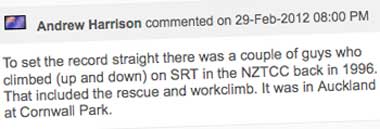According to Andy Harrison of Harrison Rockets fame, kiwi tree climbers first used SRT Work Positioning (in a TCC) back in 1996 - that's sixteen years ago..
In another first, Auckland contract climber, Johno Smith is now world recognized for his use of the Unicender while climbing single line.
More recently, Asplundh aerial arborist Guy Clark entered the NZ TCC history books when he completed the Aerial Rescue and Work Climb at the NZ Arbor sanctioned Taranaki Open TCC in February while using the Singing Tree Rope Wrench.
The 'Wrench' allowed Guy to climb on a single line while still utilizing a traditional friction hitch.
And earlier this week Treetools blogged about the progress made by the NZ Arbor Education and Training Committee in recognizing the different forms of single rope technique; namely, SRT Ascent and SRT Work Positioning.
As far as Treetools is aware, New Zealand Arbor may be the first ISA affiliated chapter to differentiate between the two forms of single rope technique in tree work.
So what you say? Well… just stop and think about this for a minute.
New Zealand holds both men and women's world tree climbing titles, the men and women's world foot lock records, the ISA Vice president is a kiwi, we have a prominent kiwi arborist on the ITCC Technical Advisory Committee… and some of these guys are on the NZ Arbor E & T Committee. So, like it or not, they do have a major influence on the future of tree climbing in NZ and possibly the rest of the world.
More importantly, the E & T committees decision to accept the two different forms of SRT is a direct reflection of this countries acceptance of single rope work positioning in tree work.
Treetools has said it before, and we'll say it again, NZ Arbor and the kiwi tree climbing community are definitely leading the way when it comes to single rope work positioning.

